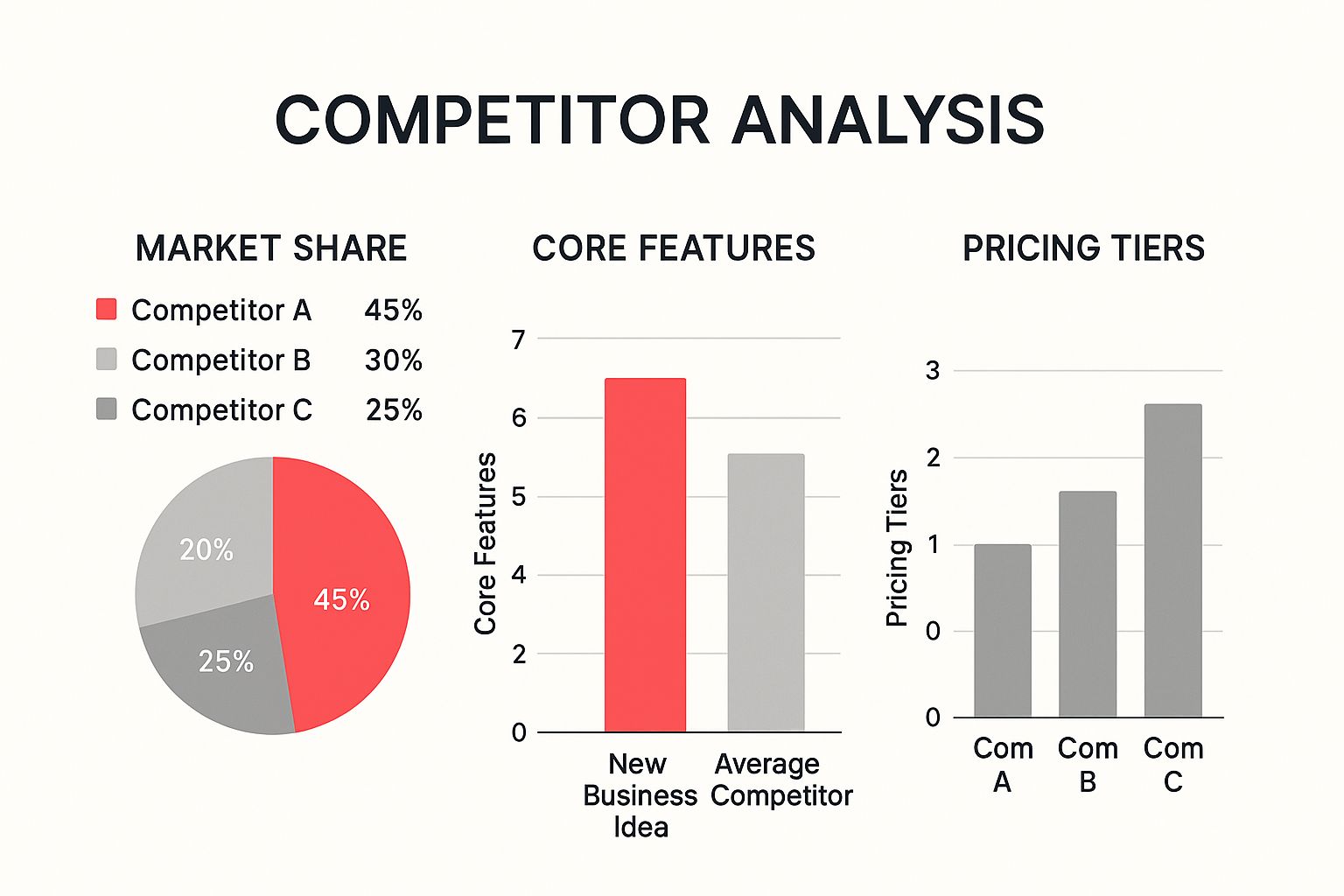
Why Business Idea Validation Makes or Breaks Your Success

Launching a business in Canada is an exciting venture. However, enthusiasm alone won't guarantee success. A strong understanding of the Canadian market, a well-defined vision, and, most importantly, validation are essential. This isn't simply a first step; it's the foundation upon which your entire business is built.
Validating your business idea is paramount, especially in a diverse market like Canada. One of the biggest hurdles Canadian entrepreneurs face is understanding market demand. Statistics Canada reports that using third-party data can help illuminate industry trends and demand.
For example, in 2020, Statistics Canada found that small businesses comprised approximately 98% of all businesses in Canada. Many of these rely on accurate market research to flourish. Market validation involves collecting real-world data. This can include polls, in-depth industry research, and direct customer feedback. These efforts determine whether your product or service truly solves a problem.
Understanding the Canadian Market
The Canadian market possesses unique characteristics. Regional variations, distinct consumer preferences, and even regulatory differences can significantly impact your business. This means your validation methods must be tailored to this specific context. Before launching your business, understanding the Canadian market is essential. You can explore various strategies to validate your business idea.
This means going beyond basic market research. It involves deeply understanding what resonates with Canadian consumers. Overlooking these vital details can be a costly oversight. It can lead to wasted resources and, ultimately, business failure.
Avoiding Costly Mistakes: Validation in Action
Imagine building a house. You wouldn't begin construction without blueprints. Starting a business without validation is similar to building on unsteady ground. You might invest heavily in a product or service, only to find there's no market demand.
This can lead to significant financial losses and take a heavy emotional toll. Validation helps you sidestep this pitfall. Confirming market demand early allows you to make informed investments. This helps mitigate risks and improves your chances of sustained success.
Building a Strong Foundation for Success
Validation provides a data-driven roadmap, replacing guesswork with strategic decisions. It helps you understand your target audience, their pain points, and whether your solution effectively addresses their needs.
This insight is invaluable. It enables you to refine your business strategy. You can then create a product or service that resonates with the Canadian market. Ultimately, validation lays the groundwork for sustainable growth and a thriving business.
Identifying High-Value Customer Pain Points Worth Solving

Before validating your business idea, you need a deep understanding of your target customer. Who are they? What problems keep them up at night? And most importantly, why would they open their wallets for your solution? This section explores proven methods to pinpoint those high-value customer pain points worth addressing, especially within the Canadian market.
Creating Detailed Customer Personas for the Canadian Market
Building detailed customer personas is the first step. This goes beyond simple demographics. It means diving deep into the specifics of your ideal customer's life. Think about their daily frustrations, their hopes for the future, and even how their region shapes their perspective.
For example, a customer persona for a tech startup in Toronto will look vastly different from one for a resource-based company in Alberta. Understanding these regional nuances within Canada is crucial for effective business idea validation. This includes considering regional buying habits, cultural factors, and specific local preferences. This detail helps you tailor your validation approach and speak directly to your target market.
Uncovering True Buying Intent: The Art of the Customer Interview
Customer interviews are incredibly valuable tools. But there's a crucial difference between polite interest and a genuine desire to buy. Many entrepreneurs fall into the trap of confirmation bias, looking for validation instead of honest criticism.
That's where structured interview frameworks become essential. By asking open-ended questions and truly listening to the responses, you'll uncover the real motivations and needs of your potential customers. This lets you assess the viability of your business idea based on actual market demand. Plus, these interviews often reveal surprising insights that can reshape your original concept.
Vitamins vs. Painkillers: Identifying Must-Have Solutions
Not all problems are equal. Some are "vitamins"—nice additions—while others are "painkillers"—absolute necessities. Your business idea’s success depends on whether it addresses a true pain point that customers will pay to resolve.
A new app that helps organize recipes might be a vitamin. A platform that streamlines business operations for small businesses in Canada, saving them time and money, is more likely a painkiller. Recognizing this distinction early is crucial for efficient resource allocation and long-term success.
Transforming Feedback into Actionable Business Intelligence
Raw feedback is only as good as your analysis of it. Customizable interview templates and pattern recognition tools can turn scattered notes into actionable business intelligence. This means finding recurring themes, ranking pain points by importance, and uncovering hidden opportunities.
This structured process allows you to make data-driven decisions instead of relying on gut feeling. This provides a strong foundation for validating your business idea, setting you up for success in the Canadian market. By tailoring your product or service to your target audience's specific needs, you dramatically increase the likelihood of a successful launch and continued growth.
Market Research Strategies That Reveal Hidden Opportunities
Validating your business idea in Canada takes more than a cursory Google search. You need market intelligence to confirm your concept's potential. This means using the wealth of resources available to Canadian entrepreneurs, from government data to competitor analysis.
Leveraging Canadian Resources for Market Validation
The Canadian government offers various resources to help businesses thrive. Statistics Canada offers demographic data, industry trends, and economic indicators for specific Canadian regions. Industry associations and chambers of commerce offer insights into the competitive landscape. Leveraging these resources offers crucial information for validating your business idea within the Canadian market. You might also be interested in this resource on sitemaps: How to master sitemaps.
Market research is essential for validating business ideas in Canada. Primary market research, involving direct interaction with potential customers, helps you understand their needs and pain points. This can involve surveys, focus groups, and releasing a minimum viable product (MVP). The Canadian Innovation Centre offers services like Market Evaluation Validation studies, which focus on technology and business propositions. In Canada, where the startup failure rate can be high, thorough market analysis is key. This helps entrepreneurs understand customer preferences and industry benchmarks, vital for refining ideas and attracting investment. For more information, see this helpful resource: Validating your business idea through market research.
Designing Effective Surveys for Reliable Data
Surveys can be powerful tools for validating business ideas. However, poorly designed surveys lead to inaccurate results. Create concise questions that avoid leading language, and ensure your sample size reflects your target audience. Surveying only friends and family creates bias and doesn't represent the broader market. Using validated survey templates and best practices will improve your research quality, providing valuable data on market demand.
Competitive Analysis: Unveiling Market Gaps and Advantages
Understanding your competition is critical. A thorough competitive analysis helps identify market gaps, potential advantages, and areas where your business can excel. Determine your main competitors, analyze their offerings, and understand their pricing.
To illustrate, the following infographic visualizes competitor data, including market share, feature comparisons, and pricing tiers.

The infographic shows Competitor A holds the largest market share. However, the new business idea offers more core features. The pricing tier analysis shows varied strategies, suggesting opportunities for differentiation. This analysis highlights how your business can stand out and informs product development, marketing, and sales. It reveals potential advantages, like offering more features or targeting a niche.
To further break down different research approaches, let's look at a comparison:
Market Research Methods Comparison
This table compares different market research methods for business idea validation, showing their relative costs, time requirements, and effectiveness for different types of businesses.
| Research Method | Cost | Time Required | Best For | Limitations |
|---|---|---|---|---|
| Surveys | Low to Moderate | Short to Medium | Gathering quantitative data, understanding customer preferences | Can be superficial, response rates can be low |
| Focus Groups | Moderate | Medium | Exploring complex issues, gaining in-depth qualitative insights | Small sample size, potential for groupthink |
| Competitor Analysis | Low | Short to Medium | Identifying market gaps and opportunities, understanding competitive landscape | Requires accurate and up-to-date information |
| MVP Testing | Moderate to High | Medium to Long | Testing product viability, gathering real-world user feedback | Can be expensive and time-consuming, requires development resources |
| Government Data Analysis | Low | Short to Medium | Understanding market trends and demographics, identifying industry opportunities | Data may not be specific to your niche |
This table highlights the trade-offs between cost, time, and depth of information for different research methods. Choosing the right mix of methods is crucial for effective validation.
Estimating Market Size and Revenue Potential
Before significant investment, estimate the addressable market size and revenue potential. Define your target market in Canada, calculate potential customer numbers, and project potential sales based on your research. This is vital for assessing financial feasibility and determining if your idea can generate sufficient profit within the Canadian market. This planning forms the basis of a strong financial plan.
Data-Driven Validation: Beyond Gut Feelings and Guesswork

Successful Canadian entrepreneurs don't rely on just optimism; they rely on evidence. This section reveals how data analytics can validate your business idea, giving you statistical confidence in its potential. This goes beyond simple market research and dives into the numbers that truly matter. You might be interested in our blog sitemap for additional resources.
Accessing and Interpreting Key Market Data
Many entrepreneurs overlook valuable, publicly available data. Resources like Statistics Canada and industry-specific databases provide a wealth of information about market trends, demographics, and economic indicators.
This data, specific to the CA region, offers crucial insights into consumer behaviour and market dynamics. Learning how to access and interpret this information is a game-changer.
For example, Statistics Canada provides detailed regional data, allowing you to tailor your business idea to specific provinces or cities. Additionally, exploring industry reports provides a deeper understanding of the competitive landscape and potential challenges.
Statistical analysis is key to validating business ideas in Canada. Understanding data accuracy and validation methods ensures quality research findings. In September 2020, Statistics Canada emphasized data accuracy in a video presentation, discussing methods to describe accuracy in terms of validity and correctness. Find more detailed statistics here.
This data-driven approach empowers Canadian entrepreneurs to make informed decisions, identify market gaps, and enhance their chances of success. Using data also makes your business idea more appealing to investors, as validated products are generally more fundable.
Establishing Meaningful Validation Metrics
Not all metrics are created equal. Vanity metrics, like social media followers, might look impressive but don't necessarily indicate market viability. Instead, focus on actionable metrics directly tied to revenue potential.
These might include:
- Conversion rates
- Customer lifetime value
- Monthly recurring revenue
These metrics give a clear picture of your business idea's potential for sustainable growth.
For example, if you're launching a SaaS product, tracking the number of free trial users who convert to paying customers is a far more valuable metric than the number of website visits. To refine your market research, learn how to effectively research your target audience.
Using Analytics Tools to Identify Trends and Growth Potential
Accessible analytics tools, even free ones, empower you to identify trends, market size, and growth potential within your specific industry. These tools can analyze website traffic, social media engagement, and market data, revealing valuable patterns and insights.
By understanding these trends, you can refine your business idea and target the right audience with the right message. For example, Google Trends can reveal search volume for keywords related to your business idea.
This data offers insight into public interest and potential market demand. This data-driven approach allows for more informed decision-making and increases your chances of success in the competitive Canadian market. Understanding regional differences is particularly important in Canada, and data analysis tools can help you tailor your approach accordingly.
To help illustrate the key metrics for validation, let's look at the following table:
Key Validation Metrics by Business Type
This table outlines the essential metrics entrepreneurs should track when validating different types of business ideas, showing threshold values that indicate potential success.
| Business Type | Primary Metrics | Secondary Metrics | Warning Signs | Success Indicators |
|---|---|---|---|---|
| E-commerce | Conversion Rate, Average Order Value | Customer Acquisition Cost, Churn Rate | High cart abandonment rate, low repeat purchase rate | Conversion rate > 2%, AOV growth, decreasing CAC |
| SaaS | Customer Lifetime Value, Monthly Recurring Revenue | Churn Rate, Customer Acquisition Cost | High churn rate, low trial-to-paid conversion | LTV > 3x CAC, MRR growth |
| Mobile App | Daily/Monthly Active Users, Retention Rate | Average Revenue Per User, Session Duration | Low retention rate, declining DAU/MAU | Growing DAU/MAU, high user engagement |
| Service-based | Customer Acquisition Cost, Customer Lifetime Value | Client Retention Rate, Project Profitability | High CAC, low client retention | Decreasing CAC, high repeat client rate |
As you can see, the metrics you prioritize will depend significantly on your business model. Choosing the right metrics and tracking them diligently is crucial for data-driven validation.
Building MVPs That Validate Without Breaking the Bank
Validating your business idea doesn't require a flawless product. The real key is strategic simplicity. This section explores building Minimum Viable Products (MVPs). These efficiently test your core value proposition with minimal investment and maximum learning, allowing you to gather crucial feedback before committing significant resources.
Canadian Startup Case Studies: MVPs in Action
Real-world examples illustrate the power of a well-executed MVP. Several Canadian startups began with cleverly designed MVPs, achieving early validation and paving the way for future success.
-
Case Study 1: A service-based company offered a limited, free version of its platform to a select group of users. This allowed them to gather feedback and refine their offering before a full launch.
-
Case Study 2: A product-based startup created a landing page with a waitlist. This helped them gauge interest before developing their physical product.
-
Case Study 3: An e-commerce business began by selling a small selection of products through an online marketplace. This approach tested demand before investing in a dedicated website.
These examples demonstrate different validation approaches for various business models. They highlight how a simple MVP can confirm market demand and guide product development. Check out our guide on how to master sitemaps.
Essential Features vs. Future Iterations: A Practical Framework
Building an MVP involves making tough decisions about features. Determine which are essential for testing your core hypothesis, and which can be added later. Focus on functionalities directly addressing your customers' primary pain points.
A practical framework for prioritizing features includes:
- Must-Have: Core functionalities absolutely essential for the MVP to function.
- Should-Have: Important features that enhance the user experience, but aren't essential for the core offering.
- Could-Have: Desirable features that can be added later, based on user feedback and market demand.
- Won't-Have: Features outside the scope of the MVP, to be considered later.
This framework promotes a lean approach, keeping your MVP focused and cost-effective. Focusing on essential features also speeds up development, allowing faster feedback and iteration.
Setting Up Meaningful Tests and Collecting Actionable Feedback
A successful MVP launch requires careful planning. This includes setting clear testing goals, defining your target user group, and choosing the right feedback mechanisms.
Here are some key steps:
- Define clear objectives: What are you trying to learn from your MVP?
- Identify your target users: Who are you testing your MVP with?
- Choose feedback methods: Will you use surveys, interviews, or in-app analytics tools like Google Analytics?
- Analyze the results: What does the feedback tell you about your business idea?
Objective data collection and analysis is crucial for informed decision-making. For example, user feedback revealing confusion about a core feature allows you to refine the design or user interface.
Leveraging Canadian Resources for Cost-Effective MVP Development
Canadian entrepreneurs have access to resources for cost-effective MVP development. These include:
- Government grants and programs: Explore federal and provincial programs supporting startups and innovation.
- Incubators and accelerators: These programs offer mentorship, resources, and networking opportunities for early-stage businesses.
- Local communities and meetups: Connect with other entrepreneurs for valuable insights and support.
Leveraging these resources can minimize development costs and maximize your chances of success in the Canadian market. For example, many incubators provide access to shared workspaces and discounted software.
Pivot Strategies Based on Validation Outcomes
Interpreting MVP results objectively allows for strategic pivots when necessary. This might involve:
- Iterating on the product: Refining features based on user feedback.
- Changing the target market: Focusing on a different customer segment.
- Revising the business model: Adjusting your pricing strategy or revenue streams.
A data-driven approach enables informed decisions about your business idea. This ensures you build a product people actually want, setting the stage for sustainable growth. This adaptive approach is especially valuable in the dynamic Canadian business landscape.
Financial Validation: Ensuring Your Idea Can Actually Profit
Market interest is a great starting point, but it doesn't guarantee profitability. This section explores the essential financial validation process, confirming your idea can generate sustainable profits within the Canadian market. This requires a data-driven approach, going beyond wishful thinking to truly understand your revenue and costs.
Creating Realistic Revenue Projections
Accurate revenue projections are the first step. This involves understanding the size of your target market in Canada, your potential pricing strategies, and anticipated sales volumes. Avoid overly optimistic forecasts. Instead, ground your calculations in realistic market data and the customer feedback you’ve gathered during your validation process. For instance, if your market research suggests a 5% market penetration in the first year, use this conservative figure for your initial revenue projections.
Understanding Your True Cost Structure
Understanding your cost structure is equally critical. This encompasses not only direct expenses like materials and marketing but also indirect costs such as legal fees, accounting, and office space in Canada. Accurate cost projections are essential for determining your break-even point – the point where revenue equals expenses. Knowing your break-even point helps you determine the viability of your business model and if the potential profit justifies the required investment.
Determining Profitability Potential in the Canadian Market
With realistic revenue and cost projections in hand, you can assess your profitability potential. Factor in the specific aspects of the Canadian market, including taxes, regulations, and regional economic variations. Calculate your potential profit margins – the percentage of revenue remaining after all expenses are deducted.
Testing Pricing Strategies Through Customer Feedback
Pricing significantly impacts profitability. Test various pricing models through customer surveys and market analysis. Analyze competitor pricing within Canada to understand appropriate price ranges. Gather feedback on your proposed pricing to ensure it aligns with customer expectations and their perceived value. This process helps you pinpoint the optimal price that maximizes both revenue and customer satisfaction.
Calculating Key Financial Metrics and Benchmarks
Understanding key financial metrics is crucial for assessing the viability of your business idea. These metrics include:
- Gross profit margin: The percentage of revenue remaining after subtracting the cost of goods sold.
- Net profit margin: The percentage of revenue remaining after deducting all expenses.
- Return on investment (ROI): The profit generated for every dollar invested.
Compare your projected metrics against industry benchmarks in Canada. This comparison provides a valuable benchmark for your potential success and highlights areas for improvement.
Financial Red Flags: Recognizing Potential Failure
Be aware of potential financial red flags. These could include:
- Unrealistic revenue projections: Projections far exceeding industry averages.
- Underestimated costs: Failing to account for all potential expenses.
- Negative cash flow: Insufficient cash to cover operating expenses.
- Long break-even period: An extended timeframe to achieve profitability.
Early identification of these red flags can save you time and resources, allowing you to revise your business plan accordingly. This careful approach helps avoid financial pitfalls and prepares you for a successful venture.
Practical Guidance: Break-Even Analysis, Cash Flow Projections, and Funding Requirements
Perform a thorough break-even analysis to determine the sales volume needed to cover your costs. Create realistic cash flow projections to ensure you can meet your financial obligations. Assess your funding requirements to determine if you need external investment. Thorough financial planning helps you secure the necessary resources for growth. When planning your funding strategy, consider Canadian-specific funding opportunities and resources like the Business Development Bank of Canada (BDC).
Building a successful business in Canada requires robust financial validation. By concentrating on realistic financial projections, understanding your cost structure, and recognizing potential risks, you can improve your chances of long-term success.
Ready to establish a thriving online presence for your validated business idea? WebFluence Digital LLC offers the tools and strategies you need. Explore our platform and learn how we can help you achieve market dominance: WebFluence Digital LLC










